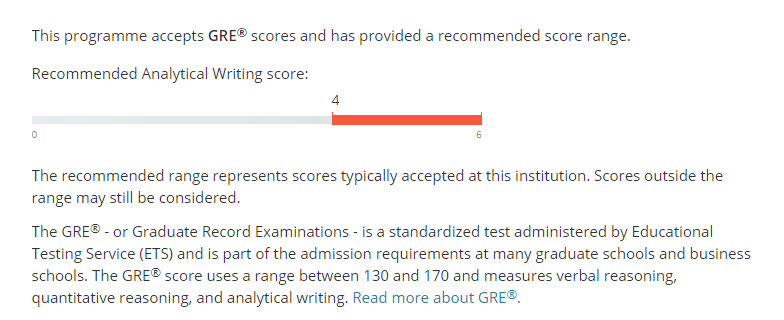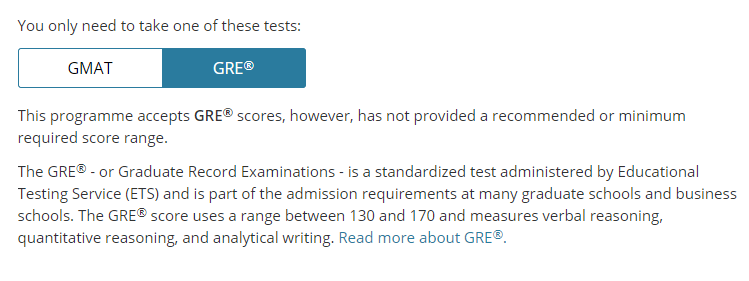How to communicate GRE® General Test score information when reaching new applicants
Call it a relevancy test – students are first interested in finding out the requirements when they’re thinking about applying to your programme or university.
Increasingly, exams like the GRE® General Test have become standard requirements for students who are seeking post-graduate options globally; and, before students fill out an application, they want to know which scores they will need.
We know, however, that in some cases the admission benchmarks can’t be set so easily. Sometimes – whether we’re admitting students, or recruiting employees – we really want to have flexibility about minimum requirements, to make room for varying strengths and capacities.
Below we’ll go through some details about how to approach the subject of communicating GRE® General Test scores to your future applicants through the Studyportals websites.
GRE® General Test scores and information transparency
When students are looking for a degree programme or option, they often have the feeling that information is buried; they have to download pamphlets, request more information, or navigate a labyrinth of links before they find the answers to their questions. This is especially crucial for degree programme applications.
Universities are starting to improve how readily and straightforwardly they display information. Nevertheless, for students, knowing exactly what materials, scores, grades, or credentials are required for the programme they’re applying for is crucial.
Having all requirements lined up allows students to plan backwards: how much time and budget they will need to reserve – starting from the required result and planning all necessary steps back to the point of beginning – to be able to make the application deadline for the program of their choice. The sooner and more easily students can find this information, the more comfortable they’ll feel about their decision to applying and taking tests
Similarly, before students sit down to take tests – especially the GRE® General Test – they want to know what scores they should aim for. So that students at least know which scores will be considered or which ones they ought to try and achieve, they can have a clearer idea of what they need to focus their energy on before they apply for the programme they’re interested in.
GRE® General Test score requirements vs. recommendations
Depending on the subject or degree programme, GRE® General Test requirements will change according to what you can expect of your students. Moreover, when students see “required score”, or “minimum score”, they can feel a little daunted. Students have written dozens of blogs on how they feel about taking the GRE® Test. In gifs:
For this reason, surely, universities have resisted telling students that they must have a specific GRE® Test score in order to apply. Also, depending on timelines, students will often take the test while they’re applying to post-graduate programmes – prompting them to submit and send scores to their programmes without knowing beforehand what their scores are.
To avoid this kind of nightmare, it’s better that universities and programmes avoid giving a minimum score requirement entirely. Although you want to be clear about admission requirements, listing an explicit GRE® General Test score requirement can actually make things more daunting.
Instead, university programmes and department directors are encouraged to specify a recommended score.
There are two benefits to this:
- Students will feel less intimidated and pressured in the face of the GRE® General Test score. You don’t want to turn away students if they turn out to have difficulty taking high-pressure tests. If you use words like “required” or “minimum”, they can be triggering keywords, deterring students from taking the test if they don’t reach that number.
- You have more (not less) transparency when you say a “recommended” score. If you clearly define or establish a recommendation, then you’re being clear about what helps a potential applicant or student stand out. Not only are you telling them what you are looking for; you’re telling them what scores they need in order to be competitive against other applicants.
In this way, you’ve made it possible for students to know, rather than having to guess, what you want from your applicants. If you say you recommend a score, students have a much clearer picture of what makes for an ideal candidate, and what will set them apart in their applications. More transparency, in this case, will make student applicants more confident and comfortable as they proceed forward.
Displaying recommended GRE® General Test scores on Mastersportal
Studyportals wants to help students plan properly for their GRE® General Test. And, because standardised tests take a lot of planning, studying, and preparing, it’s important that GRE® General Test score information is clear from the very beginning.
Over the past six months, Studyportlas has been collecting all available data about which universities work with GRE® General Test and the specific score requirements or score range they use. Now students can see this information under a programme’s admission requirements, as listed on Mastersportal.
If a university accepts the GRE® General Test and has a recommended score range, the information on Mastersportal will look like this:
If a university accepts the GRE® General Test, but has not specified the required (minimum) or recommended score, we advise students to get in touch with the university’s administration for the details:
If a university does not work with the GRE® General Test, we will simply inform students about the other requirements that apply for the given programme:
Students, who apply want to be sure that they stand out among other applicants; why not specify how they can do that, and what scores you recommend for them to have in order to succeed?
Keep an eye on the improvements we are launching every month:
Finding best fit
Simplifying search results
Encouraging website registrations
Mobile-friendly display
Improving search results
Insights into visa requirements
Adding transparency about admission chances
An introduction to Product Innovation at StudyPortals









